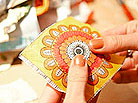DECOUPAGE workshops — learn how to transform various objects into stunning decor pieces

The dates, times and themes of these workshops are:
28 May, 10 am — Decoupage jewellery
The focus of the meeting will be decoupage jewellery. This will offer the opportunity to get familiar with the principles of gluing a motif onto a difficult, cylindrical surface, and make 'minified' versions of decoupage. The participants will also be presented with the challenge of decorating a wooden jewellery set — a bracelet and earrings.
4 June, 10 am — Decoupage under glass
The next meeting of the cycle will provide the chance to deal with new materials. Making use of classic and rice paper as well as other decorations, the participants are going to decorate a plate using the reversal of the previously learnt method, that is — decoupage under glass.
11 June, 10 am — Decoupage on wood
The participants will be decorate a plate using the serviette decoupage technique, and applying lacquer to give it a 'cracked' look.
All classes within the decoupage cycle are meant for both beginners and advanced participants who wish to broaden their knowledge and develop skills.
Workshop instructor: Alina Oleśniewicz
Workshop Prices:
A pass for all three workshops costs 105 zł
A single workshop entrance fee is 38 zł
Place: Artystic Cafe in Katowice
Contact us if you want to take part or have any question:
phone +48 32 259 90 40 extension number 13
or Aneta Zasucha phone +48 510 853 090
edukacja@bwa.katowice.pl

The BWA Gallery Art Club — artistic expression various workshops Our gallery's Art Club — artistic expression workshops, provide participants with the opportunity to become acquainted with various techniques for producing...

Decoupage (from a French word decouper, meaning 'to cut out') is the technique of decorating objects with purpose-made motifs cut out from paper serviettes. These paper cutouts are first arranged into a pattern and then glued on to a previously painted or suitably prepared surface such as wood, metal, glass, plastic or ceramics. To start with, the surface of the object is covered with multiple coats of lacquer so that the motif that has been stuck on to it blends smoothly in with the rest and is then impalpable to the touch. The motif then looks as if it were painted on.










